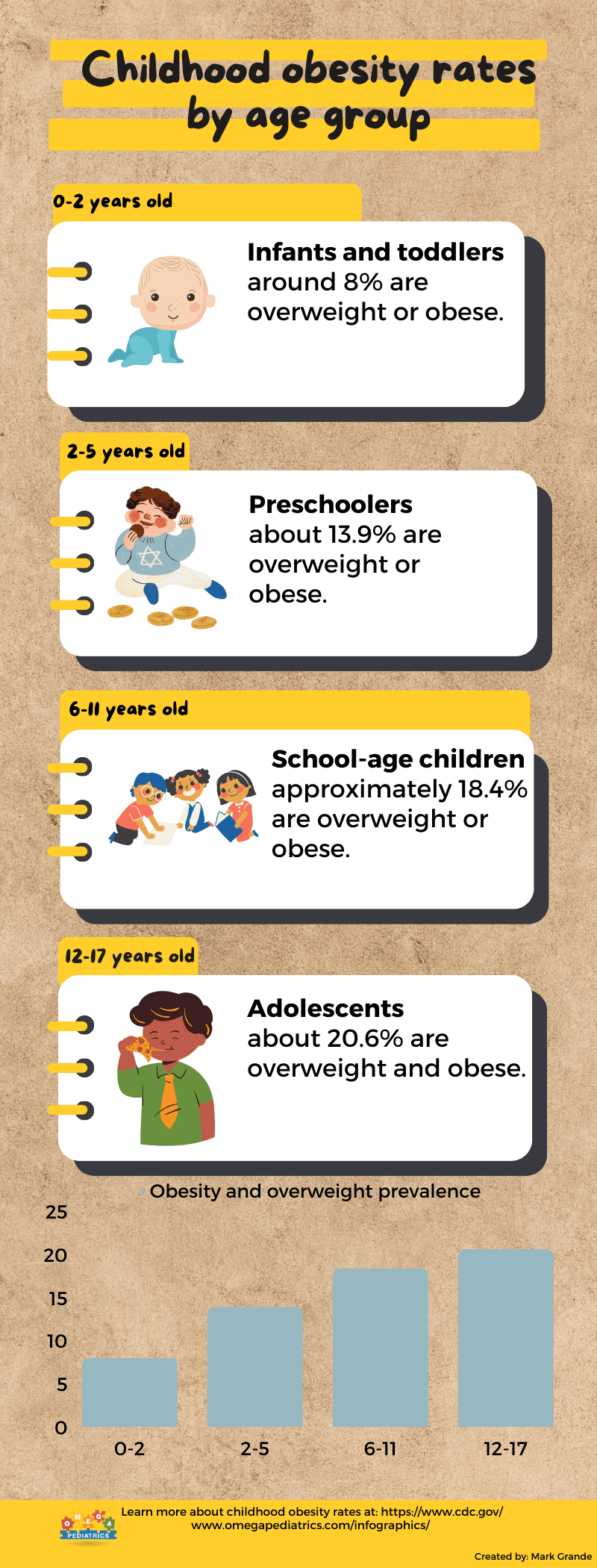
Childhood obesity has become a concerning public health issue worldwide, with significant implications for the well-being and future health of children. The prevalence of overweight and obesity varies across different age groups:
Infants and toddlers
Even at such a young age, the rates of overweight and obesity are a cause for concern. Approximately 8% of infants and toddlers are overweight or obese. Factors contributing to this include improper feeding practices, lack of physical activity, and the introduction of unhealthy foods.
Preschoolers
As children transition into the preschool age group, the prevalence of overweight and obesity increases. Around 13.9% of preschoolers are classified as overweight or obese. Factors such as sedentary behaviors, excessive screen time, and the availability of unhealthy food options contribute to this trend.
School-age children
During the school-age years, the prevalence of overweight and obesity continues to rise. Approximately 18.4% of school-age children are overweight or obese. Factors such as poor dietary habits, limited physical activity, and the influence of advertising and marketing of unhealthy foods contribute to the high rates.
Adolescents
Adolescence is a critical period when the risk of overweight and obesity significantly increases. Around 20.6% of adolescents are overweight or obese. Factors such as hormonal changes, peer influences, increased independence in food choices, and a decline in physical activity levels contribute to the rising rates during this stage of development.
Addressing childhood obesity
The high prevalence of childhood obesity necessitates comprehensive strategies aimed at prevention, intervention, and promoting healthier lifestyles. Here are additional key aspects to consider:
- Promoting healthy eating habits: Encouraging a nutritious and balanced diet rich in fruits, vegetables, whole grains, and lean proteins while limiting the consumption of sugary beverages, processed foods, and snacks high in fat and sugar.
- Increasing physical activity: Encouraging regular physical activity and reducing sedentary behaviors are vital in combating childhood obesity. Promoting active play, sports participation, and incorporating physical activity into daily routines are effective strategies.
- Enhancing education and awareness: Providing education about the importance of healthy eating, physical activity, and the risks associated with obesity is crucial. This includes teaching children, parents, and educators about nutrition, portion sizes, and making informed food choices.
- Creating supportive environments: Schools, communities, and families play significant roles in creating environments that support healthy behaviors. This includes providing access to nutritious meals, promoting active transportation, implementing physical education programs, and reducing the availability of unhealthy food options in schools and communities.
- Collaboration and policy changes: Collaboration among healthcare providers, educators, policymakers, and community organizations is essential to implement policies and interventions that support healthy lifestyles for children. This may include regulations on food marketing to children, promoting healthier food environments, and creating opportunities for physical activity.
By addressing childhood obesity through a comprehensive and multi-faceted approach, we can strive to improve the health and well-being of children and reduce the long-term consequences associated with obesity-related diseases. Early intervention and sustained efforts are key to preventing and reversing the trends of childhood overweight and obesity.
Conclusion: Combating Childhood Obesity for a Healthier Future
In conclusion, the escalating rates of childhood obesity present a pressing public health challenge, impacting children across various age groups. From infants to adolescents, the prevalence of overweight and obesity underscores the urgency for proactive and comprehensive strategies.
As we examine the data revealing concerning rates at each developmental stage, it is evident that multiple factors contribute to this complex issue. Addressing childhood obesity requires a holistic approach encompassing prevention, intervention, and the promotion of healthier lifestyles.
Encouraging healthy eating habits, fostering increased physical activity, and enhancing education and awareness are pivotal elements in the fight against childhood obesity. The collaboration of schools, communities, and families is crucial in creating environments that support these healthier behaviors.
By implementing policies and interventions, such as regulating food marketing, promoting nutritious food environments, and facilitating opportunities for physical activity, we can collectively combat the roots of childhood obesity. The key lies in sustained efforts, early intervention, and a shared commitment among healthcare providers, educators, policymakers, and communities.
In striving for a healthier future, it is our collective responsibility to create an environment where children can thrive, free from the burdens of obesity-related diseases. Through these concerted efforts, we aim not only to reverse current trends but also to pave the way for a generation that embraces and embodies lifelong health and well-being.



